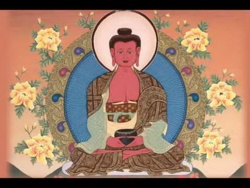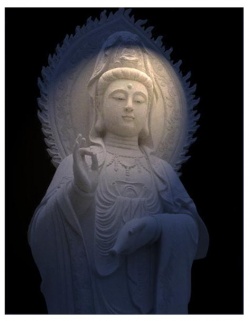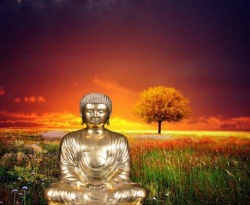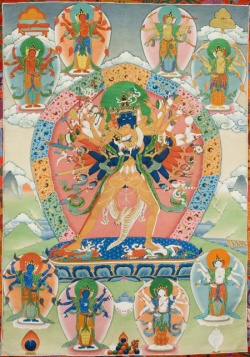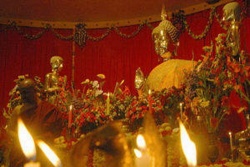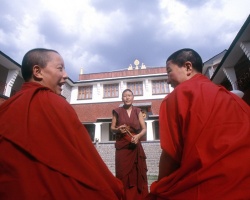A Survey of the Sanjo Wasan of Shinran Shonin.
(1) Opening the Book
Shinran's three volumes of Wasan are a kind of Pure Land equivalent of the Dharmapada, for they draw on the entire corpus of Pure Land tradition, philosophy and practice and leave us with succinct and inspiring verses, which are memorable and accessible guides to the Dharma.
As we begin to discover the Wasan we often need to delve more deeply into the Dharma, for we are sometimes confronted with ideas and concepts that are new and challenging.
Though they may posit a lifetime of work for the reader, the value of the Wasan is that their content is elegant.
The books are portable but also we are able to cut through extraneous and irrelevant concerns to get to the essence of the Dharma.
After all, considering the eternity of our wandering in samsara - one lifetime is a very short time indeed - the privilege of coming in contact with the Dharma is so great that we cannot afford to waste a second in extraneous pursuits.
Finally, although Shinran nowhere specifically says so, the Wasan are nevertheless a manifestation of the 17th Vow of Amida Buddha.
This Vow is the "Vow that all Buddhas Praise My Name", such praise being the means by which the Name is heard and beings are called to "entrust themselves" to the Primal Vow.
(2) Reading the Book
Reading important and, especially, succinct works like the Wasan in translation is, unfortunately, a potentially perilous endeavour.
It is all the more perilous when it is remembered that the decisive matter of our salvation is being explored. One word misunderstood could result in fatal errors.
Luckily, English speakers have two very good resources available to them.
For my part, the most useful translation is in the Ryukoku Translation Series, volumes 4, 6 and 7.
These are the three volumes that make up the Sanjo Wasan cycle.
Anyone who really wants to study the Wasan closely will find this translation a rich resource because it has detailed footnotes and cross-references.
It is necessary, however, to buy the earlier publications in the Ryukoku Translation Series since some references in the footnotes are to translations of other Pure Land texts in the series.
The Shin Buddhism Translation Series includes the Sanjo Wasan cycle as well.
What I like about this translation is that it includes Shinran's marginal notes.
These are particularly valuable as a resource for clarifying his intention.
A further most useful resource is "A Glossary of Shin Buddhist Terms". There are very few terms in the Sanjo Wasan that are not included in this useful little book.
It uses all previous translations of Shinran's Japanese language writings as its reference so as an aid to clarifying the terminology that one finds in the Wasan it is invaluable.
(3) Songs of Light
Bearing in mind all I have said so far, I would now like to take you with me on the marvelous journey of the Sanjo Wasan.
Working one's way through this cycle is like flying, like tasting the world of ultimate freedom, like looking into the pure and radiant house of the Dharma; absorbing one's self in the clear blue sky.
It is a journey we can all take, not only by reading and studying the Wasan but also by treasuring them - even, in time, committing them to mind.
When we survey the Sanjo Wasan as a whole, a cosmic drama engages us, transcending the detail of each verse. It begins with a single, magnificent and decisive fact - Amida Buddha, the Dharmakaya, whose brilliance is omnipresent.
At the end of the first volume, Jodo Wasan, we see his light and power in the words of Shakyamuni and learn of the power of his Vow as expressed in his name, Namu Amida Bustu.
Amida's light sweeps through history as his truth becomes more clearly known in the lives and teaching of the seven Pure Land Masters.
Finally, in the Shozomatsu Wasan Amida's light is no longer frankly evident in our dark times but wondrously shines in the living Nembutsu springing from the hearts of those who plainly and sincerely surrender to the shinjin of Amida Buddha.
The beginning of everything of concern to us is Amida Buddha.
Shinran's verses begin in the Jodo Wasan as a reflection of the "Gathas in Praise of Amida Buddha" by T'an-luan.
A statement of intent prefaces this incandescent early section of the Jodo Wasan, focusing, as they do, on the light of Amida Buddha.
The purpose of the Wasan is made clear. They are an extension of the Nembutsu, the manifestation of the 17th Vow of Amida Buddha:-
If, when I attain Buddhahood, innumerable Buddhas in the lands of the ten quarters should not all praise and glorify my name, may I not attain perfect enlightenment.1
The Wasan carry the significance of the Nembutsu and are the expression of shinjin.
Those who have Faith sincere and true,
Uttering Amida's Name,
With the thought of Buddha ever mindful,
Desire to repay His Benevolence.2
This verse makes it clear that Shomyo Nembutsu ("uttering Amida's Name, with thought of Buddha ever mindful") is the way in which we live out our response to the joy and relief in awakening to Amida's shinjin.
The verses which follow shine throughout, not only with Amida's light but call, to all who hear, to respond to his light by entrusting themselves.
Amida Buddha's name here continues in its relation to the 17th Vow and is not only the expression of our debt but the vehicle for the call of Amida's name throughout the universe.
As Shinran says in explaining the Nembutsu in the Kyo Gyo Shin Sho: -
...kimyo [i.e., namu) is the command of the Primal Vow calling to and summoning us.3
In verse 50 - in concluding the section of the Jodo Wasan which are based on T'an-luan's "Gathas in Praise of Amida Buddha" - Shinran again reminds us of the purpose of the Nembutsu and also of the Wasan: -
I have praised the Buddha's Mercy [or Wisdom) and Virtue
So that the sentient beings of the ten quarters may hear it.
Those who have already attained Faith
Should always try to repay his benevolence.4
So far, Shinran has established Amida Buddha's reality, power and light.
He has explained how his light manifests itself in the Nembutsu-Faith of those who entrust themselves.
Now, Shinran goes on to celebrate the way that Amida Buddha's light can be seen to shine in human history.
Shinran begins the Hymns on the Three Sutras with a list of those people who acted in such a way as to bring about the revelation of Amida's light and his Primal Vow.
Amida Buddha and his attendant Bodhisattvas, Avalokiteshvara and Mahasthamaprapta are seen to act in Shakyamuni Buddha and the story of the tragedy, which befell the royal household of Magadha.
The event is related in the Contemplation Sutra, and it is the first instance of a person (Queen Vaidehi) awakening to Amida's shinjin.
Thus the transmission of Amida Buddha's shinjin begins in this world of suffering. Immediately, however, Shinran's hymns go back to recall the first moment at which Shakyamuni presented the teaching of Amida, as related in the Larger Sutra.
Then he extends the revelation of Amida Buddha and the power of his light and name to other parts of the Mahayana canon.
Still working in the world of birth-and-death, the second volume of the Sanjo Wasan recalls the ways in which the seven Pure Land Masters responded to Amida's light and developed insight into the working of his primal Vow.
Amida Buddha is seen as active and gradually bringing about a full understanding of his truth until, finally, a mature understanding, suitable for our times shines forth in the life and teaching of Honen, Shinran's teacher.
Our teacher, Genku, appeared in the world, and,
While spreading the One Vehicle of the Universal Vow,
Throughout all of Japan
The proper conditions for the Pure Land (teaching) arose.5
At last! From deep in lost aeons Amida's Vow and light arose, entering the world of birth-and-death in tangible form at the time of Shakyamuni.
Working its way more and more deeply into human consciousness as the need for the Vow deepened, Amida's light bursts forth in all its clarity and glory in Master Honen:
From the working of the Wisdom Light
Our teacher, Genku appeared and,
Revealing the true intent of the Pure Land teaching,
He explained the selected original Vow.6
In the Shozomatsu Wasan we enter a dark age in which even the light of Amida shining forth from the heart of Honen has been extinguished.
We enter the world of the last volume of the Sanjo Wasan, in which the mature, rounded and completed teaching and purpose of Amida's Vow works its powerful call in the everyday life of ordinary people.
Our only teacher, our only light, now, is the Primal Vow itself. Amida's light is no longer visible and no teacher lives who radiates it.
With the passage of time the universe has turned cold and all that remains for us is to entrust ourselves to the Primal Vow. Referring to the power of the Primal Vow extending even into these dark times, Shinran sings: -
In the long night of ignorance it is the torch:
The wisdom-eye is in darkness; yet do not sorrow.
In the vast sea of birth-and-death it is the raft:
The hindrance of evil karma weighs heavy; yet do not grieve.7
The all-pervading theme of the Shozomatsu Wasan is that there is nothing left upon which we can rely but the Primal Vow of Amida Buddha.
We cannot rely upon our practice, the Bhikshu Sangha or even Shinran.
Defiled karma is from the beginning unformed;
It is formed through delusions and perversions,
Though the nature of mind is pure from the beginning,
There are no people of truth in this world.8
(4) Conclusion.
The Sanjo Wasan has always been a source of light and insight for me. But I cannot but be moved by the drama of the cycle itself.
From the brilliant and radiant power of the primordial enlightenment of Amida Buddha we first witness the play of the light in the world at large and feel its irresistible call.
As history proceeds we witness its power in the hearts of great and enlightened teachers until - for Shinran, especially - its joyful illumination emanates from the heart of Honen.
Finally, though, in the existential reality of life as we now know it, as Shinran clearly understood, we discover that there is nowhere we can turn any more except to the name of the Buddha, and that alone.
1.The Three Pure Land Sutras, A Study and Translation. Hisao Inagaki, p. 243.
2. Jodo Wasan, Ryukoku Translation Series IV, p. 26.
3. The Collected Works of Shinran. Jodo Shinshu Hongwanji-ha, Kyoto. Shin Buddhism Translation Series, p. 38.
4. Op. cit. p. 78
5. The Koso Wasan, The Hymns on the Patriarchs by Shinran. Ryokoku Translation Series VI, p. 123.
6. Op. cit., p. 124
7. Shozomatsu Wasan, Shinran's Hymns on the Last Age. Ryukoku Translation Series VII, p. 36.
8. Op. cit., p. 107.
Source
http://www.adelaideshinbuddhistdojo.com.au/shinranwasan/sol.htm
